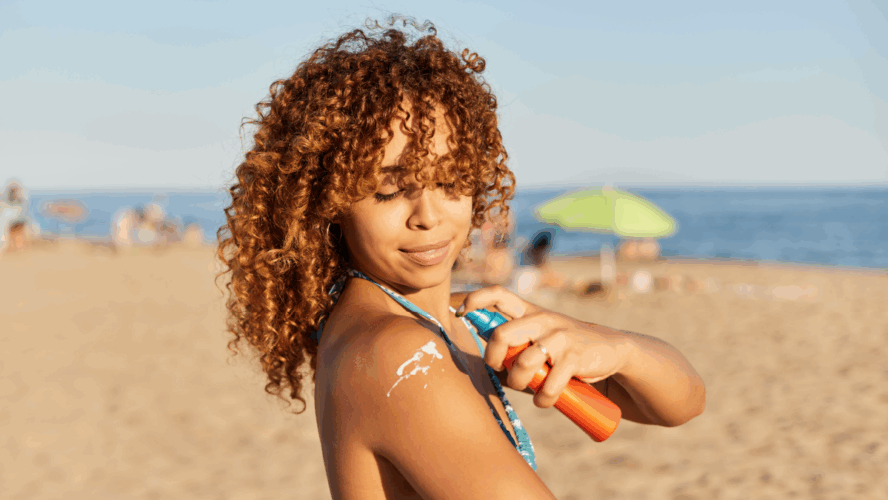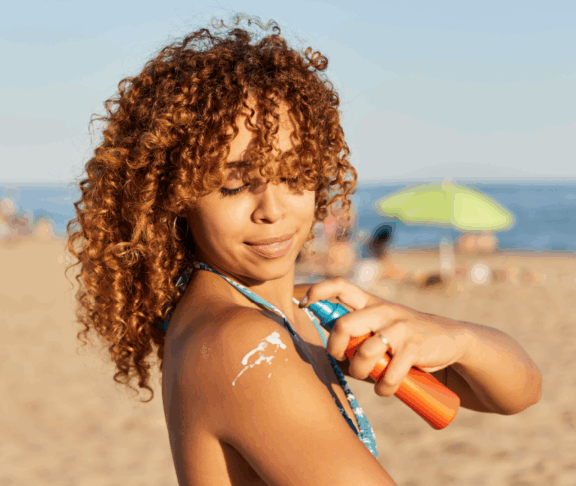
Kelly Johnston
Model & Content Creator,
Ontario
Kelly Johnston, a 38-year-old model and content creator from Ontario, knows how serious it can get. “My first skin cancer looked like a little scab above my eyebrow,” she says. “It turned out to be basal cell carcinoma. I needed surgery, and I was left with a scar that shook my confidence. And that was just the beginning.”
No tan is worth it,” says Kelly. “I wish I’d learned that earlier.”
Since then, Kelly has had multiple skin cancers removed, including a melanoma on her inner thigh. “It was small, like a freckle,” she says. “Completely different than my earlier ones. But melanoma? That word hits differently.”
Now, she gets checked every three months, undergoes photodynamic therapy to treat recurring cells on her face, and shares her story to help others take sun safety seriously.
The sun’s harmful ultraviolet (UV) rays are the #1 risk factor for melanoma and skin cancer, causing 85% of all skin cancers in Canada. The risk is rising: in 2024 alone, 11,300 people were diagnosed with melanoma, including 4,500 women. Yet many still skip sunscreen, avoid sun-protective clothing and hats, take pride in their “healthy glow,” and shrug off sunburns.
1: Know your skin, check it monthly
Catching melanoma early can save your life. Learn the ABCDEs of melanoma: Asymmetry, Border, Colour, Diameter, and Evolving. If you see changes, visit your doctor for a dermatologist referral.
Fact: Many women don’t realize using UV lamps to cure acrylic nails may increase their risk of acral lentiginous melanoma — a type of melanoma that appears on the palms, soles, or under the nails.
2: Book an Annual Skin Check
Unlike most other cancers, melanoma can be seen on the skin. When caught early, survival rates reach 85%. Don’t wait! schedule annual skin checks with your doctor or check if the Mole Mobile, presented by Neutrogena®, is near you.
3: Sunscreen isn’t optional
Apply SPF 50+ UVA/UVB broad-spectrum, water-resistant sunscreen generously 30 minutes before sun exposure. Reapply every two hours—even on cloudy days.
Dr. Ivan Litvinov, Dermatologist and clinical scientist, puts it plainly: “The best way to get melanoma is to get a couple of sunburns throughout the year.”
Tip: Sunscreen can make you feel safe to stay out longer, but that risks more damage. Sunscreen is one part of your routine, add hats, shade, and avoid peak sun hours (11 am–3 pm, May–August).
4: Protect your loved ones
Sun safety isn’t just personal; it’s something we pass on. Wearing sunscreen, covering up with sun-protective clothing (UPF 50+), choosing shade, and getting skin checks sets an example. This models healthy behaviour for children, parents, and loved ones.
“Even one blistering sunburn in childhood or adolescence more than doubles your chances of developing melanoma later in life.” says Dr. Litvinov
5: Make Sun Safety a Daily Habit
Sun protection should be as routine as brushing your teeth. Whether it’s sunny, overcast, or even snowing – UV rays are always present. Build habits that last.
Learn more at melanomacanada.ca/sun-safety


